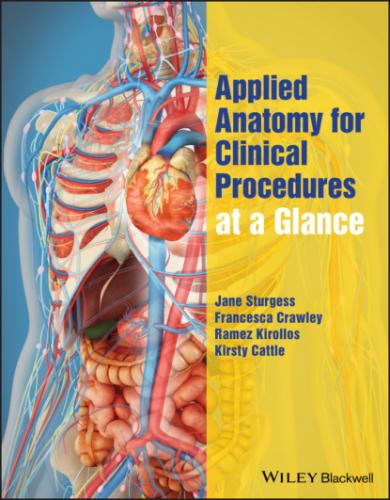13 Chapter 13Figure 13.1 Equipment required.Figure 13.2 Chest lead positions.Figure 13.3 Surface anatomy of the heart.
14 Chapter 14Figure 14.1 Equipment.Figure 14.2 Sagittal anatomy of the upper airway.Figure 14.3 Technique oropharyngeal airway: (a) size the airway, (b) open th...Figure 14.4 Soft tissue trauma following poorly inserted oropharyngeal airwa...
15 Chapter 15Figure 15.1 Equipment.Figure 15.2 Technique nasopharyngeal airway: (a) size the airway, (b) making...Figure 15.3 Sagittal anatomy of correctly placed nasopharyngeal airway.
16 Chapter 16Figure 16.1 Different LMAs.Figure 16.2 Patient position for insertion of LMA (plus sagittal anatomy).Figure 16.3 How to hold the LMA.Figure 16.4 Anatomical position of a correctly positioned LMA.Figure 16.5 Soft tissue trauma following poorly inserted LMA.
17 Chapter 17Figure 17.1 Equipment required.Figure 17.2 Patient positioning.Figure 17.3 Procedure – see text for explanation.Figure 17.4 Internal jugular landmarks.Figure 17.5 Chest X‐ray showing central venous catheter in correct position....
18 Chapter 18Figure 18.1 Equipment required.Figure 18.2 Patient positioning.Figure 18.3 Procedure.Figure 18.4 Internal jugular landmarks.Figure 18.5 Chest X‐ray showing central venous catheter in correct position....
19 Chapter 19Figure 19.1 Equipment required.Figure 19.2 Patient positioning.Figure 19.3 Procedure.Figure 19.4 Subclavian vein landmarks.Figure 19.5 Chest X‐ray showing central venous catheter in correct position....
20 Chapter 20Figure 20.1 Equipment.Figure 20.2 Patient position.Figure 20.3 Lead position.Figure 20.4 Synchronising the cardioverter.Figure 20.5 Charging the cardioverter.Figure 20.6 ECG pre DC cardioversion.Figure 20.7 ECG post successful DC cardioversion.
21 Chapter 21Figure 21.1 Equipment.Figure 21.2 Patient positioning and “window of safety”, bordered by pectoral...Figure 21.3 Thoracic anatomy. Note the position of the neurovascular bundle ...
22 Chapter 22Figure 22.1 Equipment.Figure 22.2 Patient positioning and ‘window of safety’. Aspiration can be pe...Figure 22.3 Connection of cannula to three‐way tap and syringe with position...Figure 22.4 Thoracic anatomy. Note the position of the neurovascular bundle ...
23 Chapter 23Figure 23.1 Equipment.Figure 23.2 Different NG types.Figure 23.3 Patient position.Figure 23.4 Estimate the length of insertion by holding the nasogastric tube...Figure 23.5 Chest X‐ray showing NGT in correct position, tip going below dia...
24 Chapter 24Figure 24.1 Equipment.Figure 24.2 Patient position.Figure 24.3 Surface anatomy.Figure 24.4 Three‐way tap and manometer.Figure 24.5 Anatomical structures the needle will pass.Figure 24.6 Problems (a) bone only – articulated lumbar vertebrae, lordosis ...
25 Chapter 25Figure 25.1 (a) Equipment trolley, including syringes, needles, cleaning pad...Figure 25.2 Patient position for (a) iliac crest or (b) sternal aspirate.Figure 25.3 Posterior aspect of bony pelvis.
26 Chapter 26Figure 26.1 Equipment.Figure 26.2 Landmarks for aspiration site.Figure 26.3 Abdominal wall anatomy.
27 Chapter 27Figure 27.1 Equipment.Figure 27.2 Landmarks for aspiration site.Figure 27.3 Abdominal wall anatomy.Figure 27.4 ‘z’ track to avoid overlapping skin and peritoneal puncture site...
28 Chapter 28Figure 28.1 Equipment.Figure 28.2 Knee surface anatomy with approaches for knee arthrocentesis.Figure 28.3 Lateral anatomy of knee.Figure 28.4 Bursae around the knee joint.
29 Chapter 29Figure 29.1 Equipment.Figure 29.2 Skin layers.Figure 29.3 Shave biopsy. Holding the blade almost horizontal to the skin “s...Figure 29.4 Punch biopsy. (a) The punch. (b) In use.Figure 29.5 Excision biopsy. (a) Make an elliptical incision around the lesi...
30 Chapter 30Figure 30.1 Equipment. Needle holder, suture scissors, appropriate suture ma...Figure 30.2 How to mount a needle. Note the needle is mounted at the junctio...Figure 30.3 Different suturing techniques. (a) Inverted/buried sutures. (b) ...
31 Chapter 31Figure 31.1a Equipment for bowel anastomosis.Figure 31.1b Equipment for vascular anastomosis.Figure 31.1c Stapling devices used for bowel anastomosis. © Ethicon, Inc....Figure 31.2 Different configurations of possible anastomoses, e.g. (a) end t...Figure 31.3 Posterior view of mesenteric vasculature.
32 Chapter 32Figure 32.1 Equipment.Figure 32.2 Procedure: (a) infiltrate region with local anaesthetic, (b) mak...Figure 32.3 Breast anatomy, showing lactiferous ducts.Figure 32.4 Park’s classification of perianal abscesses: (1) Intersphincteri...
33 Chapter 33Figure 33.1 Equipment.Figure 33.2 (a) Patient position – ‘sniffing the morning air’. (b) Technique...Figure 33.3 Sagittal section of the open airway.
34 Chapter 34Figure 34.1 Equipment.Figure 34.2 ‘Sniffing the morning air’ position.Figure 34.3 Introduction of the laryngoscope blade and sweeping of the tongu...Figure 34.4 Correct placement of the laryngoscope blade tip in the vallecula...Figure 34.5 Diagram to show tissue displacement with elevation vs. levering ...Figure 34.6 The laryngeal inlet.
35 Chapter 35Figure 35.1 Equipment.Figure 35.2 Ways to ventilate/ oxygenate post needle cricothyroidotomy: eith...Figure 35.3 (a) Preparing the needle for insertion (b) preparing your trolle...Figure 35.4 Patient position and surface anatomy.Figure 35.5 Needle insertion and anatomical structures you pass.
36 Chapter 36Figure 36.1 Anterior neck surface anatomy and interior anatomy.Figure 36.2 Procedure. After locating and stabilising the cricothyroid membr...
37 Chapter 37Figure 37.1 Equipment.Figure 37.2 Defibrillator pad positions.Figure 37.3 Cardiac action potential and the contribution of different parts...Figure 37.4 Defibrillator showing (a) ventricular tachycardia and (b) ventri...
38 Chapter 38Figure 38.1 Equipment.Figure 38.2 Patient position and surface anatomy.Figure 38.3 Needle direction and sagittal anatomy.Figure 38.4 Problems with needle insertion.Figure 38.5 Problems with safety.
39 Chapter 39Figure 39.1 Equipment.Figure 39.2 Features of the epidural needle (a) and catheter (b).Figure 39.3 Continuous loss of resistance.Figure 39.4 Sagittal section to show the anatomical structures the needle pa...
40 Chapter 40Figure 40.1 List of ‘Never Events’, for which healthcare organisations have ...Figure 40.2 The Surgical Safety Checklist elements included in the WHO paper...
Guide
1 Cover
2 Table of Contents
Pages
1 iii
2 iv
3 vii
4 1
5 2
6 3
7 4
8 5
9 6
